Crown Prince of Germany
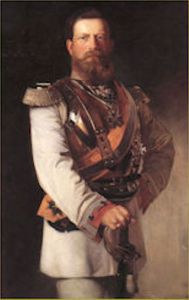 Born in Potsdam on 1st October 1831, he had an intense life as commander of the Prussian army but was troubled both because of his conflict with his father, Kaiser Wilhelm I, but above all for his health. In fact he was diagnosed with poorly diagnosed and worse treated larynx cancer. It was this that brought him to San Remo hoping that the climate of the place, known in Europe as suitable for lung diseases.
Born in Potsdam on 1st October 1831, he had an intense life as commander of the Prussian army but was troubled both because of his conflict with his father, Kaiser Wilhelm I, but above all for his health. In fact he was diagnosed with poorly diagnosed and worse treated larynx cancer. It was this that brought him to San Remo hoping that the climate of the place, known in Europe as suitable for lung diseases.
The Crown Prince of Germany, Frederick William, arrived in our city on 4 November 1887, accompanied by his wife Princess Victoria, the eldest daughter of Queen Victoria of England, his three princesses and an impressive entourage.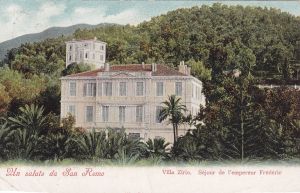
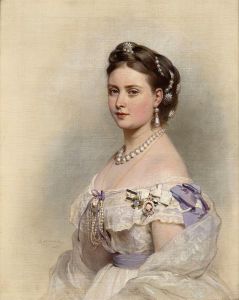 The German royal family, who arrived directly from London, where Federico Gugliemo had attended Queen Victoria's jubilee, settled in Villa Zirio, rented by Ernesto Marsaglia. The presence of the German royal family contributed to further increase the fame and renown of Sanremo, which was then beginning to make itself known all over the world as a welcoming tourist resort.
The German royal family, who arrived directly from London, where Federico Gugliemo had attended Queen Victoria's jubilee, settled in Villa Zirio, rented by Ernesto Marsaglia. The presence of the German royal family contributed to further increase the fame and renown of Sanremo, which was then beginning to make itself known all over the world as a welcoming tourist resort.
During his stay at Villa Zirio, the German Crown Prince received the visit of many representatives of the European royal houses, who had come to Sanremo specifically to visit him. It was already well known that the prince's health was rather precarious and news of his imminent departure for Germany was already circulating.
The Italian and German press took a keen interest in the state of health of Frederick William, who had come to San Remo already very ill, on the eve of inheriting a throne and an empire over which he would reign for only a few months. It was on the advice of very talented doctors that the prince decided to spend the winter in Sanremo in the hope of improving his health. Sick of cancer, Federico Guglielmo faced his terrible illness with great strength, remaining closed in his home and going out only to take solitary walks in the gardens of the villa. It had been thought that the mild climate of Sanremo could perform a miracle, but in reality Federico Guglielmo's illness was incurable, and his fate was inexorably sealed.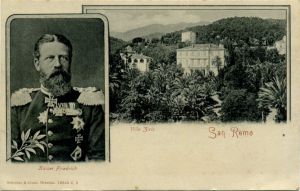 Despite this situation, on 5 November 1887 Queen Victoria of England's personal physician, Sir Morell Mackenzie, arrived from London to see if a cure could be found to cure the prince of cancer. During a visit with four great luminaries of medicine, it was decided to subject the prince to a tracheotomy. The surgery took place in February 1888, but did not give the expected results, so much so that Federico Guglielmo could only be kept alive by injections of morphine, which made him increasingly weak and dependent on drugs.
Despite this situation, on 5 November 1887 Queen Victoria of England's personal physician, Sir Morell Mackenzie, arrived from London to see if a cure could be found to cure the prince of cancer. During a visit with four great luminaries of medicine, it was decided to subject the prince to a tracheotomy. The surgery took place in February 1888, but did not give the expected results, so much so that Federico Guglielmo could only be kept alive by injections of morphine, which made him increasingly weak and dependent on drugs.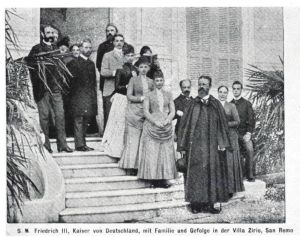 It was only at the beginning of his stay in Sanremo that Federico spent a few serene weeks, either receiving the visiting princes or making a quick appearance in the centre of Sanremo or giving parties, concerts and lunches at Villa Ziro. The
It was only at the beginning of his stay in Sanremo that Federico spent a few serene weeks, either receiving the visiting princes or making a quick appearance in the centre of Sanremo or giving parties, concerts and lunches at Villa Ziro. The 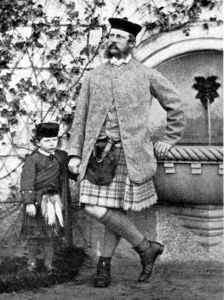 Municipal Administration of Sanremo, then, almost as if to reciprocate the prince of his presence, decided to pay homage to him by lighting the city streets with electric arches and 500 coloured bulbs on the occasion of his silver wedding with Princess Victoria. On the warmest evenings the royal family also organised outdoor dances and dances, which were attended by many citizens of Sanremo.
Municipal Administration of Sanremo, then, almost as if to reciprocate the prince of his presence, decided to pay homage to him by lighting the city streets with electric arches and 500 coloured bulbs on the occasion of his silver wedding with Princess Victoria. On the warmest evenings the royal family also organised outdoor dances and dances, which were attended by many citizens of Sanremo.
During one of these evenings a banquet was given in honour of the prince's daughters, Sophia, Charlotte and Margherita, who made their debut in society dancing with some nobles of their own age, brought for the occasion directly from Prussia and England. During this important festival music by Mozart, Telemann, Mendelssohn and Boccherini was played. In the winter between 1887 and 1888 the prince hosted, among others, an Arab sultan who used to walk around Sanremo wrapped in a large white cloak, with two greyhounds on a leash, and followed by a small crowd of black-skinned dignitaries. It was the Sultan Abdul Amid, who was on holiday in our city accompanied by his 36 wives and five eunuchs.
At the beginning of March 1888 the prince decided to leave for Germany, following the worsening health of the old emperor William I, who was to die on 9 March. On 10 March, Frederick William, who in the meantime became Emperor of Germany under the name of Frederick III, addressed a proclamation to the German people, and immediately afterwards left for the railway station, accompanied by his wife Victoria, Prince Henry, the Grand Duke of Hesse and Princess Irene and Olga of Saxony. When he arrived at the station, where a huge crowd was waiting for him, the emperor, who did not even look like a convalescent, affectionately greeted the city authorities, including the mayor of Sanremo Bartolomeo Asquasciati. After the train started up, Frederick III continued to greet the crowds who cheered him on and swept the entire route of the railway along the city streets. Shortly before the departure, Empress Victoria had wanted to donate 3,000 lire to the mayor Asquasciati, on behalf of her husband, to distribute to the poor of the city.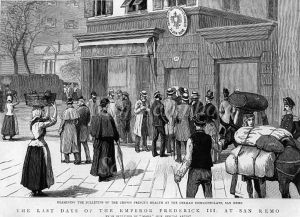 Two or three weeks before the imperial family left San Remo following the death of the old emperor, Chancellor Bismarck had managed to persuade Emperor William I to sign the decree of the so-called small representation. The imperial edict, issued on 27 November 1887, delegated Frederick's eldest son, William, to succeed his father even before his physical death. In fact, Bismarck did not want Frederick to take the throne because of his well-known friendship with England, to which he was also related to Queen Victoria. The Chancellor then sent Prince William to San Remo to persuade his father to sign the edict, which however lost all validity with the death of Emperor Julian I, who in fact opened the succession to the imperial throne to Frederick.
Two or three weeks before the imperial family left San Remo following the death of the old emperor, Chancellor Bismarck had managed to persuade Emperor William I to sign the decree of the so-called small representation. The imperial edict, issued on 27 November 1887, delegated Frederick's eldest son, William, to succeed his father even before his physical death. In fact, Bismarck did not want Frederick to take the throne because of his well-known friendship with England, to which he was also related to Queen Victoria. The Chancellor then sent Prince William to San Remo to persuade his father to sign the edict, which however lost all validity with the death of Emperor Julian I, who in fact opened the succession to the imperial throne to Frederick.
Meanwhile, on 10 March 1888, at 12.15 p.m., the imperial train arrived in Genoa station, where the King of Italy Umberto I and the Prime Minister Francesco Crispi were waiting for the Emperor of Germany. After having cordially greeted the king and the head of government, Frederick left for Berlin, where he was to be crowned emperor on 22 March. However, Frederick III reigned for only 99 days and died in Potsdam on 15 June 1888. The news of his death caused a painful impression all over Europe, and especially in San Remo many people regretted the figure of the gentle-hearted emperor who loved the arts, flowers and music.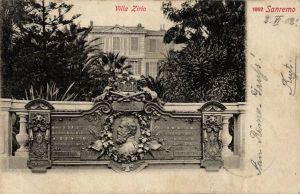 Ten years after his death, in October 1898, a delegation of German ex-combatants offered the Municipality of Sanremo a plaque commemorative
Ten years after his death, in October 1898, a delegation of German ex-combatants offered the Municipality of Sanremo a plaque commemorative 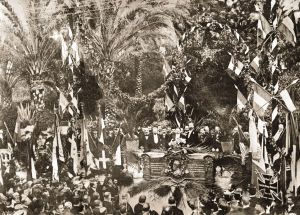 bronze statue, bearing in the centre the profile of the emperor, which was placed in the gardens of Villa Zirio, and which
bronze statue, bearing in the centre the profile of the emperor, which was placed in the gardens of Villa Zirio, and which 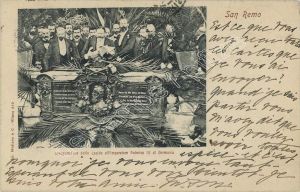 was later removed in 1915 following Italy's entry into the war against Austria.
was later removed in 1915 following Italy's entry into the war against Austria.
Many years later, on 13 October 1982, the municipal administration of Sanremo wanted to pay homage to the memory of its illustrious guest, relocating the plaque in the place where it had been placed, back in 1898, as a "wish for the continuation of the consolidated friendly relations between Italy and Germany".
(sources: “Tedeschi in Riviera. La Sanremo di Federico III tra cure climatiche, mondanità e religiosità solidaristica”, Alberto Guglielmi Manzoni, Philobiblon Edizioni 2015. Texts of different authors; archive and web images)




